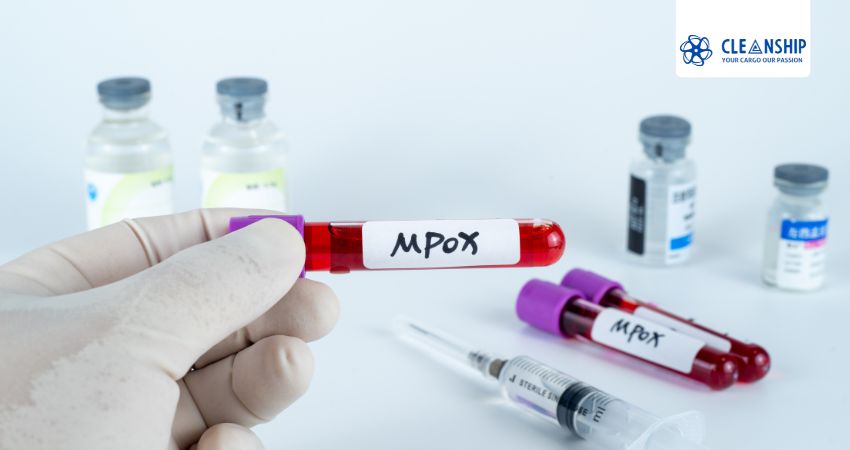The rapid spread of a new, highly virulent strain of the mpox virus across Africa has prompted the World Health Organization (WHO) to reclassify it as a public health emergency of international concern.
As a result, Singapore’s Ministry of Health, along with the Ministry of Transport and the Immigration and Checkpoints Authority, will implement enhanced surveillance efforts at its borders to prevent the spread of mpox virus. Starting from August 23, 2024, temperature and visual screening will be conducted at Changi and Seletar airports for travelers arriving from regions at risk of mpox outbreaks.
Equal screenings will be used at sea checkpoints. Health advisories will be delivered at air checkpoints, urging travelers to take personal precautions, especially if they exhibit symptoms like fever or rash.
China’s General Administration of Customs (GAC) has issued a notice that it will tighten surveillance at ports of entry to prevent the spread of mpox virus in China. In another instace, Malawi has also begun screening for mpox virus at all ports of entry.
Additionally, last week, Argentine authorities placed a cargo ship on quarantine in the Parana River due to a suspected mpox case on board, the government declared.
According to WHO, Mpox (monkeypox) is an infectious disease caused by the monkeypox virus. It can cause a painful rash, enlarged lymph nodes and fever. Most people fully heal, but some get very sick. Furthermore, WHO notes the following regarding mpox:
Anyone can get mpox. It spreads from contact with infected:
- persons, through touch, kissing, or sex.
- animals, when hunting, skinning, or cooking them.
- materials, such as contaminated sheets, clothes or needles.
- pregnant persons, who may pass the virus on to their unborn baby.
If you have mpox:
- Tell anyone you have been close to recently
- Stay at home until all scabs fall off and a new layer of skin forms
- Cover lesions and wear a well-fitting mask when around other people
- Avoid physical contact.
Key facts
- Mpox (monkeypox) is a viral illness caused by the monkeypox virus, a species of the genus Orthopoxvirus. Two different clades exist: clade I and clade II
- Common symptoms of mpox are a skin rash or mucosal lesions which can last 2–4 weeks accompanied by fever, headache, muscle aches, back pain, low energy, and swollen lymph nodes.
- Mpox can be transmitted to humans through physical contact with someone who is infectious, with contaminated materials, or with infected animals.
- Laboratory confirmation of mpox virus is done by testing skin lesion material by PCR.
- Mpox is treated with supportive care. Vaccines and therapeutics developed for smallpox and approved for use in some countries can be used for mpox in some circumstances.
- In 2022–2023 a global outbreak of mpox was caused by a strain known as clade IIb.
- Mpox virus can be prevented by avoiding physical contact with someone who has mpox. Vaccination can help prevent infection for people at risk.
Overview
Mpox (monkeypox) is an infectious disease caused by the monkeypox virus. It can cause a painful rash, enlarged lymph nodes and fever. Most people fully recover, but some get very sick.
Anyone can get mpox Virus. It spreads from contact with infected:
- persons, through touch, kissing, or sex
- animals, when hunting, skinning, or cooking them
- materials, such as contaminated sheets, clothes or needles
- pregnant persons, who may pass the virus on to their unborn baby.
If you have mpox:
- Tell anyone you have been close to recently
- Stay at home until all scabs fall off and a new layer of skin forms
- Cover lesions and wear a well-fitting mask when around other people
- Avoid physical contact.
The disease mpox (formerly monkeypox) is caused by the monkeypox virus (commonly abbreviated as MPXV), an enclosed double-stranded DNA virus of the Orthopoxvirus genus in the Poxviridae family, which includes variola, cowpox, vaccinia and other viruses. The two genetic clades of the virus are clades I and II.
The monkeypox virus was discovered in Denmark (1958) in monkeys kept for research and the first reported human case of mpox virus was a nine-month-old boy in the Democratic Republic of the Congo (DRC, 1970). Mpox virus can spread from person to person or occasionally from animals to people. Following eradication of smallpox in 1980 and the end of smallpox vaccination worldwide, mpox steadily emerged in central, east and west Africa. A global outbreak occurred in 2022–2023. The natural reservoir of the virus is unknown – various small mammals such as squirrels and monkeys are susceptible.
Transmission
Person-to-person transmission of mpox virus can occur through direct contact with infectious skin or other lesions such as in the mouth or on genitals; this includes contact which is
- face-to-face (talking or breathing)
- skin-to-skin (touching or vaginal/anal sex)
- mouth-to-mouth (kissing)
- mouth-to-skin contact (oral sex or kissing the skin)
- respiratory droplets or short-range aerosols from prolonged close contact
The virus then enters the body through broken skin, mucosal surfaces (e g oral, pharyngeal, ocular, genital, anorectal), or via the respiratory tract. Mpox can spread to other members of the household and to sex partners. People with multiple sexual partners are at higher risk.
Signs and symptoms
Mpox virus causes signs and symptoms which usually begin within a week but can start 1–21 days after exposure. Symptoms typically last 2–4 weeks but may last longer in someone with a weakened immune system.
Common symptoms of mpox are:
- rash
- fever
- sore throat
- headache
- muscle aches
- back pain
- low energy
- swollen lymph nodes.
For some people, the first symptom of mpox virus is a rash, while others may have different symptoms first.
The rash begins as a flat sore which develops into a blister filled with liquid and may be itchy or painful. As the rash heals, the lesions dry up, crust over and fall off.
Some people may have one or a few skin lesions and others have hundreds or more. These can appear anywhere on the body such as the:
- palms of hands and soles of feet
- face, mouth and throat
- groin and genital areas
- anus.
Some people also have painful swelling of their rectum or pain and difficulty when peeing.
People with mpox virus are infectious and can pass the disease on to others until all sores have healed and a new layer of skin has formed.
Diagnosis
Identifying mpox virus can be difficult as other infections and conditions can look similar. It is important to distinguish mpox from chickenpox, measles, bacterial skin infections, scabies, herpes, syphilis, other sexually transmissible infections, and medication-associated allergies. Someone with mpox may also have another sexually transmissible infection such as herpes. Alternatively, a child with suspected mpox may also have chickenpox. For these reasons, testing is key for people to get treatment as early as possible and prevent further spread.
Treatment and vaccination
The goal of treating mpox virus is to take care of the rash, manage pain and prevent complications. Early and supportive care is important to help manage symptoms and avoid further problems.
Getting an mpox virus vaccine can help prevent infection. The vaccine should be given within 4 days of contact with someone who has mpox (or within up to 14 days if there are no symptoms).
It is recommended for people at high risk to get vaccinated to prevent infection with mpox, especially during an outbreak. This includes:
- health workers at risk of exposure
- men who have sex with men
- people with multiple sex partners
- sex workers.
Persons who have mpox should be cared for away from other people.
Read Also: Safety Measures for Vessels Carrying Dangerous Cargo to Egyptian Ports





Leave A Comment